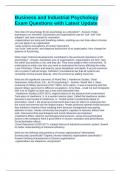Exam (elaborations)
Business and Industrial Psychology Exam Questions with Latest Update
- Course
- Institution
How does I/O psychology fit into psychology as a discipline? - Answer--Helps businesses run smoother. Businesses and organizations can be "sick" and "mal-adapted" and seek counsel for renovation -organizations are living and breathing entities, anything you can think about a human you can apply to...
[Show more]



